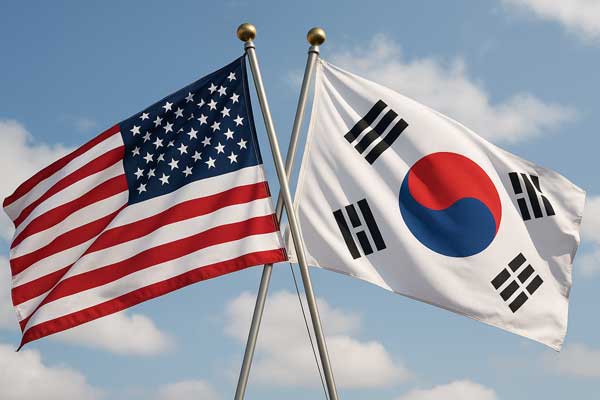US and South Korea reach high stakes trade agreement

[This picture shows a great template slide. AI-generated illustration created using ChatGPT]
On July 30, 2025, just before the August 1 tariff deadline, the United States and South Korea reached a sweeping new trade agreement that is already reshaping global trade relations.
The deal was announced by President Donald Trump and President Lee Jae-myung following months of tense negotiations, during which the U.S. had threatened to impose tariffs of up to 25% on South Korean goods.
Earlier this year, President Trump introduced a “reciprocal tariff” policy, which targeted countries running trade surpluses with the U.S.
South Korea, a major exporter of semiconductors, steel, and automobiles to the American market, found itself in the crosshairs.
The U.S. demanded broader access to South Korea’s agricultural market and regulatory concessions in pharmaceuticals and automobiles.
Rather than face harsh tariffs, South Korea negotiated aggressively.
As a result, the finalized agreement includes a major concession: a $350 billion investment fund established by South Korea, intended to bolster American industry and manufacturing.
Of the $350 billion, $150 billion will be dedicated to rebuilding the U.S. shipbuilding sector.
This includes constructing shipyards, training workers, and reinforcing the domestic supply chain.
The remaining funds are earmarked for joint ventures in key technology sectors including semiconductors, batteries, biologics, and energy.
In exchange, the U.S. agreed to reduce the proposed tariff from 25% to 15% — still higher than the 10% baseline, but far less damaging to South Korean exporters.
Moreover, South Korea pledged to import $100 billion worth of American liquefied natural gas (LNG) and other energy products over the next three and a half years.
However, South Korea refused to fully open its agricultural sector to U.S. goods, arguing that doing so would threaten national food security, especially for rice and beef — two politically sensitive commodities.
The U.S. secured several wins: significant foreign investment in American industries, increased energy exports, and a strong public narrative of trade toughness.
President Trump emphasized that the $350 billion South Korean investment would be directed toward U.S. projects “owned and controlled by the United States” and “selected by Trump,” underscoring his role in determining how the funds will be used.
Still, critics argue that the deal focuses too much on symbolic victories rather than addressing systemic issues in trade, like market competition and domestic innovation.
South Korea, meanwhile, managed to avoid the economic shock that a 25% tariff would have caused.
With its economy showing signs of contraction in early 2025, securing this deal was crucial.
However, the lingering 15% tariff and massive investment commitment raise concerns about the long-term impact on Korean taxpayers and exporters.
This agreement does not exist in isolation.
Similar deals have recently been struck with Japan and the EU.
Conversely, countries that resisted —like Brazil— faced steep penalties, including a 50% tariff hike.
South Korea’s new president, Lee Jae-myung, moved quickly to repair relations with Washington after taking office, hoping to avoid such a fate.
This agreement underscores a growing trend: trade policy as a tool for geopolitical leverage.
Both nations achieved short-term goals, but the long-term effects on their economies and alliance remain to be seen.
As global supply chains shift and political landscapes change, future U.S. – Korea negotiations may prove even more complex.

- Joseph Shin / Grade 12 Session 11
- Valley Christian High School

![THE HERALD STUDENT REPORTERS [US]](/assets/images/logo_student_us.png)
![THE HERALD STUDENT REPORTERS [Canada]](/assets/images/logo_student_ca.png)
